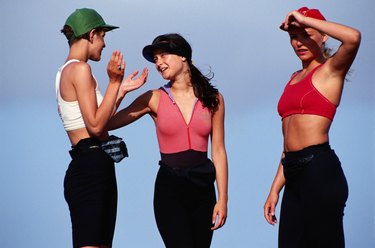
Without proper support, over time, the tissues in the breasts stretch, and the breasts will begin to sag. But don't let large breasts stop you from exercising. Jumping jacks and other vigorous exercises move large breasts a greater distance and with greater force than when engaging in less vigorous exercise, like walking. By ensuring you're supporting your breasts, you can jump into any activity, like jacks, without worry that you're damaging your breasts' delicate support system.
Breast Structure
Video of the Day
The breasts don't include any actual muscle. Instead, they are entirely supported by your skin and the Cooper's ligaments. These ligaments attach to the collar bone and pectoralis major muscle before branching off inside the breasts. Their primary function is to support the breast tissue. Because these ligaments are incredibly thin and not particularly strong, they are susceptible to stretching when the breasts move.
Video of the Day
Breast Motion
With vigorous activity, breasts do not only move up and down. They also move forward, sideways and in a circular fashion. In a study published in the November 2010 "Journal of Applied Biomechanics," researchers assessed breast displacement during jumping jacks. They found that maximum displacement was 7.36 inches. Larger breasts move farther than smaller breasts, and the resulting strain on the Cooper's ligaments can cause considerable pain and discomfort. The most effective way to protect your breasts is by wearing a properly fitted sports bra.
Encapsulation Bras
Sports bras come in two main types: compression bras and encapsulation bras. Compression bras prevent movement by squeezing the breasts to the chest. This type of bra works best for women with A or B cups. Encapsulation bras support each breast individually and work best for women with larger breasts, cup size C and higher.
Proper Fit
For good breast support during jumping jacks, proper fit is essential. Begin by measuring the distance around your chest, just under your breasts, in inches. This number gives you the numerical part of your bra size. Then, measure the distance, in inches, around your breasts. Subtract your chest measurement from your breast measurement. This number will indicate your cup size, with each inch indicating one letter. A 1-inch difference is an A cup, and a 2-inch difference is a B cup. For example, if your chest measures 38 inches and your breasts measure 42 inches, your breasts are properly supported in a 38D bra.
- Women’s Sports Medicine and Rehabilitation; Nadya Swedan
- Contemporary Sport, Leisure and Ergonomics; Thomas Reilly and Greg Atkinson
- Journal of Physiotherapy: Education Improves Bra Knowledge and Fit, and Level of Breast Support in Adolescent Female Athletes: A Cluster-Randomised Trial
- Journal of Applied Biomechanics: Three Dimensional Kinematics of the Breast During a Two-Step Star Jump